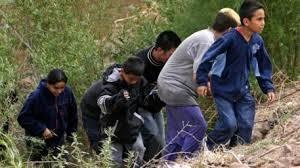Border securityProposed border security surge threatens to create ghost towns along the border -- again
The U.S. Customs and Border Patrolhas apprehended more illegal immigrants in the Rio Grande Valley in the first eight months of fiscal 2014 (160,000) than it did for all of fiscal 2013 (154,453). Last May, agents apprehended over 1,100 illegal immigrants per day in the Rio Grande Valley. Texas officials have now authorized the Department of Public Safety(DPS) to send additional law enforcement personnel to patrol areas along the Texas-Mexico border at a cost of $1.3 million each week for the remainder of the year. Some residents compared the proposed surge, announced last week, to 2013’s Operation Strong Safety, which, these residents say, resembled a police state which created ghost towns along the border where illegal immigrants became afraid to go to work or send their children to school for fear of deportation.

Influx of border-crossers may render border towns to ghost towns // Source: patch.com
Towns along the Rio Grande Valley have become “ground zero” for illegal immigrants entering Texas. To discourage illegal border crossings, Texas officials have authorized the Department of Public Safety (DPS) to send additional law enforcement personnel to patrol areas along the Texas-Mexico border at a cost of $1.3 million each week for the remainder of the year. “Securing the border is absolutely critical, and never before have we ever had so many people boldly coming across,” said State Representative Debbie Riddle (R-Tomball). “They cross the border, sit down and just wait for border patrol to pick them up.”
CBS News reports that some residents compared the proposed surge, announced last week, to 2013’s Operation Strong Safety, in which DPS agents patrolled border towns to identify illegal immigrants. Residents of the towns said the operation resembled a police state and blamed it for creating ghost towns where illegal immigrants became afraid to go to work or send their children to school for fear of deportation.
“There was a large outcry from the community because, quite frankly, right here on the border we live with a number of people who are — to be blunt — not citizens. And this has been the way of life down here for hundreds of years,” said former State Representative Aaron Pena (R-McAllen). “Last time they initiated a surge, they flooded the area with more personnel. They had set up checkpoints in various places in the Valley that were somewhat controversial because we have a number of families where the kids are American, but the parents are not Americans and so a lot of people avoided the roads.”
Despite the controversy around the 2013 surge, Texas Lt. Governor David Dewhurst believes it was effective. “Last year DPS conducted Operation Strong Safety and achieved astounding results. Crime rates related to drugs, cartels, transnational gangs, and illegal border activity plummeted because of the resources we allocated to stop illegal entry at the border. It’s time to make this type of presence on the border permanent.”
Texas officials are worried that while DHS border agents become occupied with locating housing for thousands of unaccompanied children illegally crossing into the country, fewer agents will be available to secure the border. “Texas can’t afford to wait for Washington to act on this crisis and we will not sit idly by while the safety and security of our citizens are threatened,” Governor Rick Perry said.
The U.S. Customs and Border Patrol has apprehended more illegal immigrants in the Rio Grande Valley in the first eight months of fiscal 2014 (160,000) than it did for all of fiscal 2013 (154,453). Last May, agents apprehended over 1,100 illegal immigrants per day in the Rio Grande Valley and more than half of those immigrants originate from countries other than Mexico. As Texas prepares a surge on border towns once again, residents hope the agents will refrain from inciting panic among locals. “Word of mouth spread fairly fast,” Pena said. “I think this time they will be respective of the community and not bring it to a stand still.”
